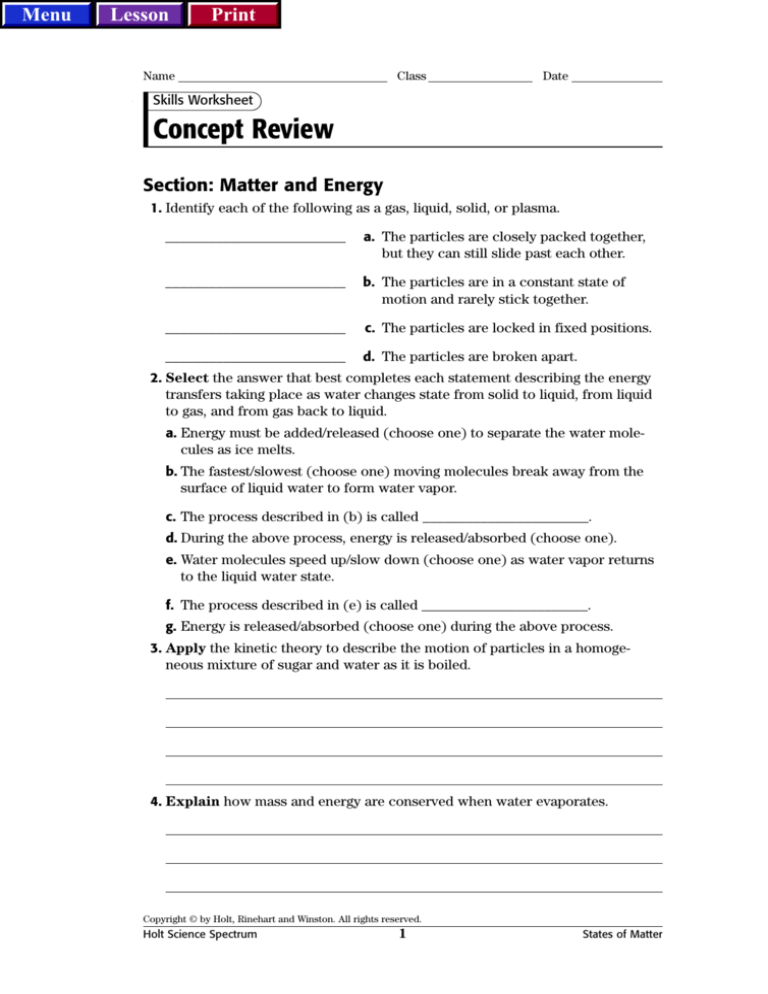
Menu
Lesson
Print
Name
Class
Date
Skills Worksheet
Concept Review
Section: Matter and Energy
1. Identify each of the following as a gas, liquid, solid, or plasma.
_________________________
a. The particles are closely packed together,
but they can still slide past each other.
_________________________
b. The particles are in a constant state of
motion and rarely stick together.
_________________________
c. The particles are locked in fixed positions.
_________________________
d. The particles are broken apart.
2. Select the answer that best completes each statement describing the energy
transfers taking place as water changes state from solid to liquid, from liquid
to gas, and from gas back to liquid.
a. Energy must be added/released (choose one) to separate the water molecules as ice melts.
b. The fastest/slowest (choose one) moving molecules break away from the
surface of liquid water to form water vapor.
c. The process described in (b) is called _______________________.
d. During the above process, energy is released/absorbed (choose one).
e. Water molecules speed up/slow down (choose one) as water vapor returns
to the liquid water state.
f. The process described in (e) is called _______________________.
g. Energy is released/absorbed (choose one) during the above process.
3. Apply the kinetic theory to describe the motion of particles in a homogeneous mixture of sugar and water as it is boiled.
4. Explain how mass and energy are conserved when water evaporates.
Copyright © by Holt, Rinehart and Winston. All rights reserved.
Holt Science Spectrum
1
States of Matter
Menu
Lesson
Print
TEACHER RESOURCE PAGE
Answer Key
Bellringer Transparencies
the water, so the water molecules are
moving faster than they were, but the
total amount of energy is the same.
SECTION: MATTER AND ENERGY
1. a. gas, molecules only
b. gas, atoms only
c. liquid, atoms only
d. gas, atoms and molecules
e. liquid, atoms and molecules
f. solid, atoms and molecules
g. solid, atoms only
h. liquid, molecules only
i. gas, atoms only
2. d, i
SECTION: FLUIDS
1. An object in a fluid medium displaces
2.
SECTION: FLUIDS
3.
4.
1. less; The buoyant force cannot equal
the gold’s weight, so the gold sinks.
2. greater; The buoyant force exceeds
the balloon’s weight, so the balloon
rises.
3. equal; The weight of the boat is balanced by the buoyant force.
4. equal; The weight of the submarine is
balanced by the buoyant force at the
depth at which the submarine cruises.
5.
6.
a set amount of fluid upon immersion.
Archimedes’ principle states that the
weight of the displaced fluid is equal
to the buoyant force exerted on the
object.
The buoyant force exerted on the
wood is equal to the weight of the
wood.
150 000 Pa
A fluid in equilibrium contained in a
vessel exerts a pressure of equal intensity in all directions.
33 250 N
As the speed of a moving fluid
increases, its pressure decreases.
SECTION: BEHAVIOR OF GASES
1. a) Boyle’s law, b) Charles’s law,
c) Gay-Lussac’s law
2. Solids have molecules fixed in relation
SECTION: BEHAVIOR OF GASES
1. a
2. b
3. a
Concept Reviews
SECTION: MATTER AND ENERGY
1. a. liquid b. gas c. solid d. plasma
2. a. added b. fastest c. vaporization/
evaporation d. absorbed e. slow
down f. condensation g. released
3. The sugar molecules will have a lower
3.
4.
5.
6.
speed on average than the water molecules because the sugar molecules are
more massive than the water molecules. As the temperature of the mixture increases, the speed of all of the
molecules will increase.
4. The total number of water molecules,
and therefore the mass, stays the
same; the molecules are just spread
out over a greater volume. Energy is
transferred from the surroundings to
to each other. Liquids have molecules
capable of sliding past each other, but
still stack together. Gases have molecules that are rarely in contact with
each other. Also, solids have definite
volume and shape. Liquids have definite volume and varying shape. Gases
have varying shape and volume.
a
c
d
Either its pressure or volume must
also change. Alternatively, both may
change. The amplitude and direction
of the changes depends on the original
temperature change.
Math Skills
PASCAL’S PRINCIPLE
1.
2.
3.
4.
80.6 N
350.0 N
293.6 N
28 cm2
Copyright © by Holt, Rinehart and Winston. All rights reserved.
Holt Science Spectrum
78
States of Matter










